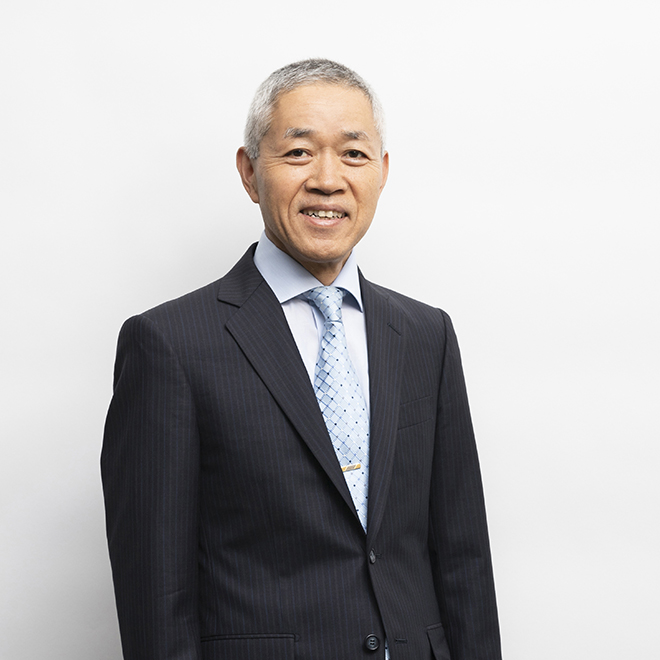Acting for Sustainability : A Legal Perspective
Feature #3: Thinking Through the Subject of Business and Human Rights
(Interview with Junji Nakagawa, Professor Emeritus at Tokyo University and Of Counsel at AMT, conducted by Shigeki Tatsuno, Partner at AMT)

| Issue | Jul 29, 2022 |
|---|

Lately, global-level issues and the UN’s 17 Sustainable Development Goals (SDGs) that indicate the goals for solving these issues have been drawing more attention. At Anderson Mōri & Tomotsune, we as legal professionals continue to look for ways to contribute to achieving these SDGs. Our lawyers have developed a wealth of SDG-related expertise in their respective fields and have put these resources at the disposal of our clients, helping them find best practice-based solutions to the many legal issues that attach to sustainable development.
In this special feature, we introduce some of the activities that have allowed our lawyers not only to commit our Firm to the UN’s SDGs, but also to position our Firm as a leader in the field of sustainability law.
For this third dialogue on in this feature series, we conduct a second interview with Junji Nakagawa, Professor Emeritus at Tokyo University (Research fields: international law; international economic law) and also Of Counsel of our firm (Please see here for the previous interview).
*Date of the interview: March 4, 2022, conducted online.
Back number
Feature #3: Thinking Through the Subject of Business and Human Rights
(Interview with Junji Nakagawa, Professor Emeritus at Tokyo University and Of Counsel at AMT, conducted by Shigeki Tatsuno, Partner at AMT)
Table of contents
Q1:Significance of Human Rights DDs
TatsunoDuring our last session together we took a broad look at the concept of “Business and Human Rights.” Today, we would like to review the concept of a “Human Rights Due Diligence” (“Human Rights DD”) in greater depth, since this topic will help us illustrate a practical approach to the issue of Business and Human Rights. Recently, requests for from our clients seeking advice on the subject of Human Rights DDs have been increasing in volume. Referring back to our last session, could you please remind us why companies need to know how to implement a Human Rights DD?
NakagawaThe United Nations’ “Guiding Principles on Business and Human Rights” (the “Guiding Principles”) that was resolved in 2011, which called for implementation of Human Rights DDs, is the origin of the drive by companies to begin to implement Human Rights DDs. Since then, U.S. and Europe have enacted a series of domestic laws that mandate the implementation of a Human Rights DD.
TatsunoIt is reported that the Japanese government, which stated in its “National Action Plan on Business and Human Rights (2020 -2025)” that it “expects” companies to implement Human Rights DD, will further proceed and formulate guidelines for Human Rights DDs to investigate and prevent the risks of human rights violations by business actors (Nihon Keizai Shimbun, February 14, 2022). According to media reports, the Japanese government will not only legislate procedures for investigating whether there is forced labor or child labor being used in a given supply chain, but also envision legislation that requires companies to implement a Human Rights DD in the future.
NakagawaYes, it seems that the Japanese government has begun to envision legislation that requires the implementation of a Human Rights DD. There is no doubt that in the future, Japanese companies should consider the implementation of a Human Rights DD regardless of whether or not they will expand to Europe or the U.S. In an age where adverse information concerning human rights abuses is easily spread through social networking sites and other media, it is essential for companies to proactively address Human Rights DDs as a management issue. Companies that implement a Human Rights DD will gain the support of a wide range of stakeholders, including employees.

Q2:Conducting a Human Rights DD (1): Formulation of human rights guidelines and utilization of outside experts
TatsunoLet’s take a look at the points that companies should keep in mind when implementing a Human Rights DD, based on the Guiding Principles. To begin with, the Guiding Principles require companies to establish human rights policies.
NakagawaYes, Principle 16 of the Guiding Principles calls for a human rights policy to be established and publicized, stating that, as a basis for entrenching responsibility for respect human rights, companies should make clear their commitment to meeting that responsibility. Once such a human rights policy has been formulated, it is necessary for it to be approved at the highest level of the company, which would normally be the board of directors in the case of a Japanese company. In doing so, it is essential to obtain advice not only from within the company, but also from outside experts, and I believe that lawyers will increasingly be consulted as legal experts.
TatsunoIn fact, I am receiving increasingly more requests for such advice.
NakagawaWhen formulating human rights guidelines, for example, the ESG Management Promotion Department of a company often takes the lead in drafting, with the participation of its legal, human resources, purchasing, and overseas departments, followed by the obtaining of advice from outside experts to confirm that the contents of the draft meet international standards. International norms include the International Bill of Human Rights (consisting of the Universal Declaration of Human Rights, the International Covenant on Civil and Political Rights, and the International Covenant on Economic, Social and Cultural Rights), the ILO’s core labor standards, the Guiding Principles, and the OECD Due Diligence Guidance for Responsible Business Conduct. Although I will not mention specific names here, some Japanese companies have formulated relatively concise human rights policies, which are signed by their representative directors and publicized.
Q3:Conducting a Human Rights DD (2) - Importance of the PDCA Cycle
TatsunoIn order to eliminate human rights risks, it is essential not only to formulate human rights policies but also to actually circulate the flow of a Human Rights DD through the so-called “plan-do-check-act” (PDCA) cycle.
NakagawaYes, the Guiding Principles envisage the following PDCA cycle for a Human Rights DD: (1) first, elaborate the principles of a Human Rights DD (Principle 17) ⇒ (2) next, identify and assess the human rights risks relevant to the company (Assessment, Principle 18) ⇒ (3) next, mitigate any negative impacts resulting from, and prevent the realization of, any further risks (Principle 19) ⇒ (4) next, track and verify the effects of the company’s initiatives (Tracking, Principle 20) ⇒ (5) finally, disclose all risk-related information (Principle 21).
(1) According to Principle 17, a company should implement a Human Rights DD to identify, prevent, mitigate and explain how to address adverse human rights impacts. Principle 17 also indicates that Human Rights DD procedures should include assessing actual and potential human rights impacts, integrating and responding to findings, tracking responses, and reporting on how companies respond to identified adverse human rights impacts. Because human rights risks can change over time depending on the state and evolution of corporate activities, a company must continuously update and implement its Human Rights DD.
TatsunoThis represents a considerable burden for a company, so we believe that it is essential for the company to know its own priorities when implementing a Human Rights DD.
NakagawaYes, the important point is to know how to establish priorities. Even if a supplier is a Tier 2 supplier for a company, the company has a responsibility to report on its relationship with said supplier in its Human Rights DD, and thus should be prioritized in its PDCA cycle. However, it is difficult for a company to actually directly influence suppliers below Tier 2 and, thus, Tier 1 and Tier 2 suppliers should be the company’s main focus.
TatsunoFrom my experience, it is very difficult to effectively implement a Human Rights DD. I should also say that it is difficult to cover the whole PDCA cycle of a Human Rights DD today, but could you give us the key points in describing step (2), assessing human rights risk, step (3), preventing and mitigating negative impacts, step (4), tracking, and step (5), disclosing information?
NakagawaFirst, step (2), risk mapping, is a prerequisite for any effective assessment (Principle 18). It is necessary to estimate, with the cooperation of outside experts, the potential human rights risks for a company and its affiliated companies based on the contents and location of its business, the composition of its workforce, and the raw materials and products that it handles. The priority issues are thereby determined and investigated in detail.
Next, step (3), in order to prevent and mitigate negative impacts on human rights (Principle 19), the results of the human rights risk assessment must be reflected in the relevant internal processes. For example, in the procurement process, the company must encourage its business partners to respect human rights as clarified in the company’s procurement policy. It is important for companies to build a sustainable supply chain that respects human rights through dialogue and cooperation with their suppliers.
As efforts for step (4), to track the effectiveness of its initiatives (Principle 20), a company must continuously follow up on the effectiveness of its planning and implementation of activities relating to its Human Rights DD and on the measures that it has undertaken, and it must do this based on appropriate qualitative and quantitative indicators. A company must then determine whether its human rights policy is reflected in its business activities, whether it has effectively responded to the impact it is having on human rights, and whether it must modify its business activities.
Finally, for step (5), a company must disclose information on these initiatives to the general public (Principle 21). The company may disclose appropriate information on its Human Rights DD policies, processes, and on the actions it has taken to mitigate or eliminate the negative impacts that it has identified. Such disclosure can take the form of a human rights report, a sustainability report, or an integrated report, and it may be published via its website, for example. When a human rights risk becomes apparent, it is desirable to publicize not only information on the actions the company has taken to prevent and mitigate the risk as well as the corrective measures it has taken, but also, if possible, the timelines involved and the indicators used for measuring potential improvements.

Q4:Human Rights DDs and grievance mechanisms
TatsunoThank you. In relation to the PDCA cycle of a Human Rights DD, should we also mention the establishment of a grievance mechanism (Principle 29)?
NakagawaYes, indeed. Principle 29 states that, as a Human Rights DD grievance mechanism, a company should establish an effective business-level grievance mechanism for negatively affected individuals and communities so that grievances are addressed early on and can be directly remediated.
TatsunoThe establishment of such a system is important.
NakagawaYes, in practice, for example, the key is to establish an internal corporate governance mechanism for human rights risks. The company might, for example, designate a responsible person or department in charge of the necessary procedures, or set up an internal reporting and consultation desk. In doing so, it is important to select an easy-to-access method that allows company stakeholders to file possible grievances, while at the same time establishing a mechanism for protecting privacy and ensuring appropriate confidentiality. It is also necessary to consider how best to create and store records. Advice from outside experts will be important in establishing and operating such a system.
Principle 31 lists (1) legitimacy, (2) availability, (3) predictability, all of which must be understood by the users of the grievance mechanisms, as well as (4) fairness, (5) transparency (sufficient explanations must be provided to the party who has filed the grievance), (6) rights-compatibility (outcomes of the grievance filing process and the remedies awarded to the grievance-filing party must accord with internationally recognized human rights standards), (7) the establishment of learning feedback loops (allowing the ongoing improvement of the grievance mechanism), and (8) an emphasis on engagement and dialogue with the company’s stakeholders; all of which are elements that will help to ensure the effectiveness of the company’s non-judicial grievance mechanisms for human rights abuses. These elements will be taken into account when establishing a human rights risk governance framework.
Q5:Summary
TatsunoIn the future, the way Japanese companies implement a Human Rights DD will become increasingly important. Might you summarize for our readers the two sessions we have had discussing this topic?
NakagawaTo begin with, there are three types of human rights risk. The first, type (a), is when the company is the direct cause of the human rights abuse (by “causation”), for example, when discrimination against women in the employment environment occurs, or when occupational safety issues arise at a manufacturing site. The second, type (b), occurs when the company contributes to the human rights abuse (by “contribution”), for example by changing an order just before a delivery date, thereby putting the supplier under pressure to violate labor standards. Finally, type (c), occurs when the human rights abuse is somehow causally linked to the company’s business, products or services (by “linkage”), for example, where minerals mined by child labor are procured and used in the company's products.
All of these are difficult issues, and the effective implementation of a Human Rights DD will never be easy. However, as I mentioned at the beginning of our discussion, the juxtaposed concept of “business and human rights” has now become an extremely important management issue for companies. For a company to put in place an internal platform for implementing a Human Rights DD, and for the company to subsequently circulate through its own PDCA cycle, measures that might be thought of as a form of “human rights risk governance” that will become increasingly important in the future. “Human rights risk governance” will not only win the support of stakeholders such as investors, but will also be a significant factor in recruiting talented young people who are sensitive to the United Nations’ Sustainable Development Goals.。
TatsunoI think we can both agree that the concept of a “Human Rights DD” is indeed a beneficial tool for companies and their stakeholders. I thank you very much for your participation in these discussions.




